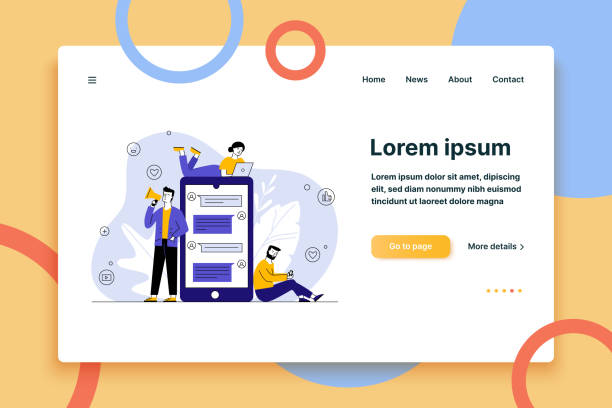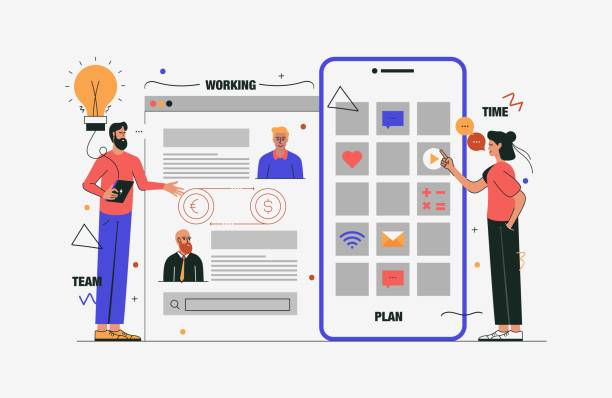An Introduction to Responsive Website Design and its Importance in the Digital Age

In today’s world, where various devices including #smartphones, #tablets, and #desktop_computers are used to access the internet, the importance of having a website that displays correctly across all these platforms is more vital than ever.
Responsive Web Design is the answer to this growing need.
This approach enables websites to automatically adapt their layout and content to the size of the user’s device screen.
The main goal of #responsive_design is to provide an optimal and seamless user experience (UX), regardless of the device used.
This not only increases visitor satisfaction but also plays a key role in improving the website’s ranking in search engines.
Ignoring this can lead to losing a significant portion of the audience, as users quickly abandon websites that do not provide a good experience.
In fact, responsive design is no longer a luxury feature but a necessity for survival and success in the online space.
This concept has transformed the web into a more flexible and accessible space.
Are you bothered by losing customers due to your online store’s outdated appearance or slow speed? Rasaweb’s expert team solves these problems with professional e-commerce website design!
✅ Increase customer trust and brand credibility
✅ Blazing speed and excellent user experience
Get a free consultation with Rasaweb right now ⚡
Fundamental Principles and Technologies in Responsive Design

Responsive web design is built upon a foundation of specific principles and technologies that enable flexibility and adaptability.
At the heart of these technologies are Media Queries in CSS3.
These queries allow developers to apply different CSS rules based on device characteristics such as screen width, height, orientation, and resolution.
For example, one can specify that a column displays fully on a desktop but appears as a row beneath the main content on mobile.
In addition to Media Queries, the use of #Fluid_Grids and #Flexible_Images are also key pillars of responsive design.
Flexible grids, instead of using fixed pixels, use relative units like percentages for element widths, allowing them to change their width based on the parent container’s size.
Flexible images, with the max-width: 100%; CSS property, ensure that images never overflow their content space and scale appropriately with screen dimensions.
A deep understanding of these technical concepts is essential for the correct and optimal implementation of a #mobile-compatible_design website.
These foundational principles enable the creation of seamless user experiences.
Advantages of Responsive Website Design for User Experience and SEO

Responsive web design offers numerous benefits for both users and search engines.
From a user’s perspective, the most significant advantage is a seamless and optimal #user_experience.
When a website displays well on any device without the need for zooming or horizontal scrolling, users feel more comfortable, and their likelihood of staying and interacting with the site increases.
This, in turn, leads to a reduction in #Bounce_Rate and an increase in #Time_on_Site, both of which are positive signals for search engines.
From an SEO perspective, Google and other search engines have explicitly stated their preference for responsive websites.
The reason is that responsive websites have only one URL, which helps search engine bots crawl and index content.
This approach prevents issues such as duplicate content that might arise from having separate mobile versions.
In fact, responsive design is considered an important ranking factor in mobile search results.
Furthermore, maintaining and updating a single website optimized for all devices is much simpler and more cost-effective than managing multiple separate versions.
This ease of management allows development teams to focus their time and resources on improving content and features, rather than on adapting code for different platforms.
This analysis shows that investing in responsive web design is a strategic and beneficial decision for any business.
| Feature | Responsive Design | Separate Mobile Design |
|---|---|---|
| URLs | One URL for all devices | Multiple URLs (e.g., m.example.com) |
| SEO | Optimized, easier crawling, strong signals | Duplicate content, crawling complexity |
| Maintenance | Easier, one codebase | More complex, multiple codebases |
| User Experience | Seamless, adapts to any screen size | May have a different experience |
Common Patterns and Considerations in Implementing Responsive Design

For successful implementation of responsive web design, developers use various patterns and techniques, each with its own advantages and disadvantages.
One of the most common patterns is #Column_Drop, where layout columns are shifted beneath each other on smaller screens.
Another pattern is #Off-Canvas_Navigation, which transforms the main website menu into a hamburger button on smaller sizes, and upon clicking it, the menu slides open from the side of the screen.
These patterns help preserve screen space and improve mobile navigation experience.
Also, #Prioritized_Content is of high importance; meaning that on small screens, critical content and main information should be prioritized for display, while less important elements should be displayed more compactly or even hidden.
There are also other considerations in the responsive design process.
For example, #Mobile-First_Design is a highly recommended approach where design and development begin for mobile devices first and then progressively expand to larger devices.
This method ensures that the site performs highly even on the smallest screens and prevents unnecessary overload on mobile devices.
Furthermore, special attention must be paid to #Site_Performance; heavy CSS and JavaScript files can slow down website loading speed on mobile devices.
Image optimization, code compression, and using lazy loading techniques for images all help improve performance and provide a fast and smooth user experience across all devices.
This analysis shows that investing in responsive web design is a strategic and beneficial decision for any business. These tools facilitate the process of implementing responsive web design.
Do you know your company’s website is the first point of contact for 75% of potential customers?
Your website is the face of your brand. With **Rasaweb**’s corporate website design services, build an online presence that earns customer trust.
✅ Create a professional and lasting image for your brand
✅ Attract target customers and increase online credibility
⚡ Get a free consultation from **Rasaweb** experts now!
Common Tools and Frameworks in Responsive Web Design

With the growing need for #responsive_website_design, a set of tools and frameworks have been developed to make the design and development process simpler and more efficient.
One of the most popular and well-known frameworks is Bootstrap.
Bootstrap is a CSS, HTML, and JavaScript framework that includes a collection of pre-designed templates and components for creating responsive and #mobile-compatible websites.
By providing a flexible grid system and pre-designed user interface elements, this framework helps developers quickly and with minimal effort build responsive websites.
Other frameworks like Tailwind CSS and Bulma also offer different approaches to responsive design, each with its own proponents.
Tailwind CSS is a utility-first CSS framework that allows developers to quickly create custom styles with helper classes.
In addition to frameworks, various tools exist for testing and debugging #responsive_design.
Modern browsers like Chrome, Firefox, and Edge offer built-in developer tools that allow developers to simulate website display across various screen sizes and examine its performance.
The use of these tools, especially #user_interface_testing on real devices, is crucial to ensure correct functionality and optimal user experience in all environments.
These tools facilitate the process of implementing responsive web design.
Challenges and Solutions to Overcome Them in Responsive Design

Despite its many advantages, implementing responsive web design is not without challenges.
One of the biggest challenges is #image_management.
Images optimized for large screens might be too heavy for mobile devices, significantly slowing down website loading speed.
The solution to this challenge is using techniques like #Responsive_Images, where the browser selects and loads the best image version based on the screen size and device resolution.
This can be achieved using the srcset and sizes attributes in the <img> tag or by using the <picture> tag.
Another challenge is #JavaScript_Complexity; JavaScript codes written for desktop versions might not work correctly or could degrade performance on mobile devices.
Optimizing JavaScript codes and using lighter libraries for mobile are among the solutions to this problem.
Furthermore, #UX_Design for touch devices can also be challenging.
Buttons and interactive elements must be large enough to be easily tappable with a finger, and there should be sufficient space between them to prevent touch errors.
These #technical issues require careful attention and repeated testing.
A general solution to overcome these challenges is to use the #Iterative_Improvement methodology; meaning that the development team continuously tests and improves the site on various devices to achieve the best possible outcome.
This #analytical approach to problems ensures the quality of responsive web design.
The Impact of Responsive Design on SEO and Digital Marketing Strategy

As previously mentioned, responsive web design is considered a crucial factor in #SEO.
Google has officially stated its preference for responsive websites in its search results, especially for searches conducted via mobile.
This means that if your website is not responsive, it might lose its ranking in search results, particularly on mobile devices.
The main reason for this preference is to provide a better user experience; Google wants to deliver the best and most relevant results to users, and responsive websites provide this experience.
Beyond SEO, #responsive_design has a significant impact on every business’s #digital_marketing_strategy.
Conversion Rate is one of the most important metrics for success in online marketing.
A responsive website that provides a positive user experience across all devices can significantly increase the conversion rate.
Imagine a user who accesses your site via mobile; if they encounter a disorganized and unusable design, they will quickly leave the site.
But if your site displays correctly, the probability that they will perform your desired action (e.g., purchasing a product, filling out a form, or contacting you) increases.
Also, #online_advertising campaigns (such as Google Ads and social media ads) that direct users to the website will be most effective when the landing page is responsive.
Responsive design increases ROI (Return on Investment) in digital marketing activities.
This analysis shows that responsive web design is an integral component of a successful digital marketing strategy.
| Metric | Positive Impact of Responsive Design | Description |
|---|---|---|
| SEO Ranking (SERP) | Increased ranking in mobile results | Google prefers mobile-friendly websites. |
| Bounce Rate | Decrease | Better user experience leads to longer user retention. |
| Conversion Rate | Increase | The purchasing or registration process becomes easier. |
| Dwell Time | Increase | Users read high-quality and readable content more. |
| Reduced advertising costs | Improved Quality Score | Optimized landing pages, more effective advertising campaigns. |
The Future of Website Design and the Position of Responsive Design

The future of website design is strongly linked to the concept of #responsiveness, and this trend is expected to continue.
With the emergence of new devices such as smartwatches, virtual reality (VR) and augmented reality (AR) devices, and even foldable screens, the need for design flexibility is more pronounced than ever.
User Experience (UX) and User Interface (UI) design, in a dynamic and adaptive manner, will be fundamental principles in these emerging ecosystems.
These developments are significant #news for designers and developers.
Furthermore, with advancements in artificial intelligence and machine learning, it can be expected that the #responsive_design process will become smarter and more automated.
Tools capable of automatically optimizing layouts based on user data and device performance are currently under development.
This will help developers design websites and web applications more efficiently for a wide range of devices.
The concept of #dynamic_adaptability will go beyond merely resizing elements and will include changes in content, functionality, and even user experience personalization based on context and user preferences.
This outlook indicates continuous evolution in the field of responsive web design and shows that this approach is not just a passing trend but a fundamental pillar in the future of the web.
Does your current website display your brand’s credibility as it should? Or does it scare away potential customers?
Rasaweb, with years of experience in professional corporate website design, is your comprehensive solution.
✅ A modern, beautiful website consistent with your brand identity
✅ Significant increase in lead generation and new customers
⚡ Contact Rasaweb now for a free corporate website design consultation!
The Importance of Responsive Website Design in Various Industries

Responsive web design is not just a technical concept but a business strategy that has gained vital importance across various industries.
In the #E-commerce industry, where users browse and purchase products using various devices, a responsive website can make the difference between a sale and a lost customer.
A seamless shopping experience on mobile, tablet, and desktop significantly helps increase customer trust and conversion rates.
In the field of #online_education, with increasing use of mobile devices to access educational content, #responsive_learning platforms provide easy access and content study for students and instructors.
This becomes even more critical in regions where access to personal computers is limited.
#News and #media websites are also heavily dependent on responsive design.
Today’s audiences expect to be able to read the latest news anytime, anywhere, regardless of their device type.
In the #tourism and #hospitality sectors, users often use mobile devices to search and book hotels or flights.
A website with a #mobile-compatible_design allows them to easily find information and make their bookings.
Even in more traditional industries like banking and financial services, providing online services through a responsive website improves customer experience and facilitates access to services.
This wide range of applications shows that responsive web design is a universal necessity across all sectors of the digital economy.
A Question of Debate: Is Responsive Design Always the Best Solution?

Despite all the advantages we listed for responsive web design, is this approach always the best and only solution in every situation? This is a #contentious and debatable topic in the web development community.
While responsive design is ideal for most websites and applications, there are scenarios where other approaches might be considered or even preferred.
For example, in some highly complex and high-performance web applications that require a completely customized user interface for each device, designing a native mobile application or a separate mobile version (Adaptive Design) fully optimized for specific devices might be a better choice.
Also, for websites with very limited budgets or a need for extremely rapid development, a simpler website with minimal #responsiveness might be considered, although this approach comes with the risk of losing mobile users.
The #technical_discussion here is whether the additional complexity in code and design to cover all responsive scenarios is always worth it, especially when a large portion of traffic comes from a specific type of device.
The answer to this question depends on the specific project needs, target audience, budget, and available resources.
However, for the vast majority of websites, especially content-driven and commercial websites, responsive web design remains the #superior_choice, and its advantages far outweigh its disadvantages.
This approach provides flexibility and broad accessibility.
Frequently Asked Questions
| Question | Answer |
|---|---|
| What is Responsive Web Design? | It is a website design method that optimizes the appearance and functionality of a website based on the screen size of the user’s device (mobile, tablet, laptop, etc.). |
| Why is responsive design important? | Due to the increasing use of various devices to access the internet, responsive design provides a better user experience, improves website SEO, and reduces maintenance costs. |
| What are the most important tools for responsive design? | Media Queries in CSS, use of relative units (such as percentage, em, rem, vw, vh), Fluid Images, and Grid Systems. |
| What role do Media Queries play in responsive design? | Media Queries allow applying different CSS styles based on device characteristics (such as screen width, height, orientation, and screen type). |
| What is the concept of Mobile First in responsive design? | It is an approach where design and development begin first for the smallest screen (mobile) and then gradually expand to larger screens (tablet, desktop). |
| Does responsive design affect website SEO? | Yes, Google prefers responsive websites because they offer a better user experience and eliminate the need for separate mobile and desktop versions, which helps improve SEO ranking. |
| What does Fluid Layout mean? | It means that the width of page elements is defined using relative units (such as percentages) instead of fixed pixel values, so they automatically adjust as the screen size changes. |
| How are Flexible Images used in responsive design? | By setting the `max-width: 100%;` property for images in CSS, it is ensured that the image never exceeds its container and its scale is maintained with screen size changes. |
| What are the differences between responsive design and adaptive design? | Responsive design uses a single layout that fluidly adapts to any screen size, whereas adaptive design uses multiple fixed, predefined layouts for specific screen sizes. |
| Are CSS frameworks like Bootstrap useful in responsive design? | Yes, frameworks like Bootstrap have a responsive Grid System and pre-designed components that make the process of building responsive websites much simpler and faster. |
And other services of Rasa Web Advertising Agency in the field of advertising
The Role of High-Quality Images in the Appeal of Health Product Advertorials
Advertorial Writing Techniques to Attract Buyers’ Attention
How Advertorials in Classifieds Strengthen Customer Trust
The Importance of Keywords in the Success of Health Product Advertorials
Optimizing Advertorials for Increased Clicks on Classified Websites
And over a hundred other services in the fields of internet advertising, advertising consultation, and organizational solutions
Internet Advertising | Advertising Strategy | Advertorial
🚀 Are you ready to transform your business in the digital world? Rasaweb Afarin, a leading digital marketing agency, with expertise in providing comprehensive solutions including SEO-optimized website design, SEO, content marketing, and social media management, is ready to assist you on your path to growth and achieving maximum visibility.
📍 Tehran, Mirdamad Street, next to the Central Bank, South Kazeroon Alley, Ramin Alley, No. 6




